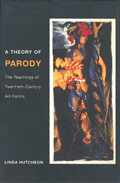A Theory of Parody:
The Teachings of Twentieth-Century Art Forms
Inspired by the lack of fit between what parody does and what people say it does, this study examines how parody “works” as a major form of modern self-reflexivity that marks the intersection of invention and critique. Arguing that parody is and always has been a flexible and multifaceted mode of expression (whose moods range from the scathingly scornful to the playful to the respectful), it looks to the teachings of actual works of modern literature, visual art, music, film, theatre, and architecture to arrive at a comprehensive assessment of the functions and modes of modern parody as a form of repetition with ironic critical distance. Through this kind of ironic playing with multiple conventions, parody combines creative expression with critical commentary, and it is this constitutive doubleness of parody that has allowed modern and postmodern art alike to recode tradition, to install difference at the heart of similarity.
Table of Contents
A New Introduction, an Old Concern
Chapter One:
Introduction
Chapter Two:
Defining Parody
Chapter Three:
The Pragmatic Range of Parody
Chapter Four:
The Paradox of Parody
Chapter Five:
Encoding and Decoding: The Shared Codes of Parody
Chapter Six:
Conclusion: The World, The Parodic Text, and the Theorist
Bibliography
